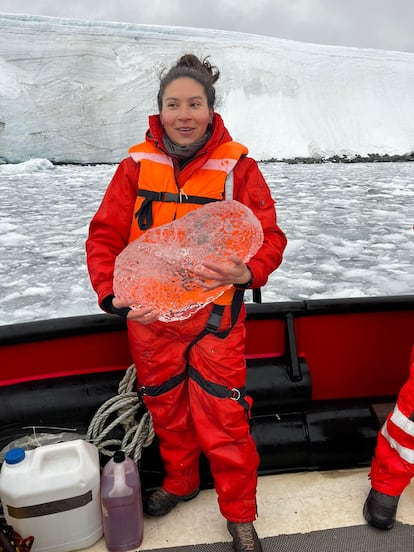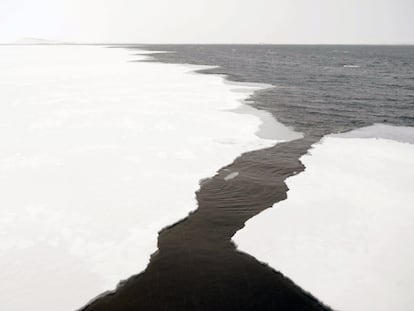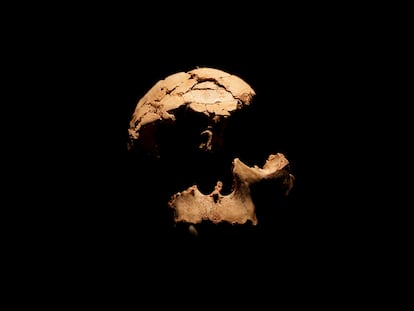The Mexican scientist who explores the colors of the poles and their connection with climate change
Glaciologist Ximena Aguilar Vega has dedicated herself to investigating the tones of the seas and ice of the Arctic and Antarctic, mixing science with art, photography, and poetry


Ximena Aguilar Vega is defined by light. Behind the spot where she is sitting to speak to EL PAÍS via video call from Scotland, a primitive color scheme can be seen. Next to it, a map of Antarctica. The image could well sum up her life, what she does for a living. As a professional biologist and glaciologist, with a master’s degree from the University of Magellan in Chile and a PhD from the University of Stirling, she has dedicated herself to researching color. Not simply color, but the changes it has on the glaciers, ice, and seas at the two poles of the world. As she says, her scientific emphasis is on studying ocean and ice tones in both the Arctic and Antarctica.
This is not merely a contemplative activity. Knowing what color change is occurring in these ecosystems provides clues as to whether there are biological and chemical processes at work. For example, Aguilar, 32, has discovered that, in areas where the sea converges with the ice, the colors are darkening, which means that there are more compounds reaching the water from the glaciers. The glaciers themselves are also becoming darker. “This is very serious, because if you darken light surfaces, what happens is that they absorb more solar radiation, generating a whole chain of negative effects, because the ecosystem gets warmer and the ice melts,” she explains.
She has witnessed this first-hand. Her first expedition to a pole was in 2018, in Antarctica. On that occasion, she made a flight to measure the sea ice using NASA’s Operation IceBridge. In 2019, she had her boots on the ground while camping at the Peruvian scientific base. “They were all very precise shades of white and blue. Just some black. That’s what the whole landscape was like,” she recalls. But when she returned in 2020, she was taken aback. “I was really shocked because that landscape had vanished. The glaciers were dark, as if brown and black dust had been dropped all over them. That had an impact on the presence of liquid water. There were also puddles and streams everywhere. And this was in just one year.”
In the Arctic, where she has been twice, the panorama is not much different. “The situation is drastic, especially in Svalbard,” she says. “There the warming is happening four to five times faster than anywhere else on the planet.”

Living in different skins
Aguilar’s relationship with the biological world began with a tree. When she was a child, despite living in the monster of a city that is the Mexican capital, she would take refuge under a tree on her street. She was interested in that world. The contemplative one, the silent one, not that of human conversations. She was also interested in color. Not only from a scientific point of view, but also from a photographic slant, another specialty to which she has dedicated herself in parallel to her research. And when one has the opportunity to travel to Antarctica, to the end of the world, to study colors, it would seem unreasonable not to want to portray everything. Again, she is a witness. So much so that she sometimes leaves her scientific skin aside, and exchanges it for that of an activist, that of an artist.
Just a pinch of light / to enlighten / our soul / our spirit / our hope is one of the verses she wrote herself for the exhibition Just a Pinch of Light, which mixed art, science, and poetry, and which she led together with Andrea Martínez, Mónica Nepote, and Liliana Zaragoza. To picture / a sustainable future / better days for all / hope for all, the poem continues.

In her third skin, that of an activist, she has also participated in conversations with the Mexican delegations to the United Nations Climate Change Summits (COP), to make her stance more radical and stronger regarding the emergency the world is experiencing. “Over time I have realized that, although science is very important, sometimes it enters a loop. It feeds, it recycles, but it always stays within the same guild. And in order to make changes, all the knowledge needs to permeate society first. Society must also play a more critical and active role,” she says.
As Aguilar herself insists, the “synergy between science and art as a tool is infallible for raising awareness about climate change. And not just anyone is saying that, but someone who has visited the poles six times. Who has seen, through her eyes and the lens of her camera, how one of the key ecosystems of our planet is changing. And someone who fears that this erosion will be repeated in the rest of the world.”
Sign up for our weekly newsletter to get more English-language news coverage from EL PAÍS USA Edition
Tu suscripción se está usando en otro dispositivo
¿Quieres añadir otro usuario a tu suscripción?
Si continúas leyendo en este dispositivo, no se podrá leer en el otro.
FlechaTu suscripción se está usando en otro dispositivo y solo puedes acceder a EL PAÍS desde un dispositivo a la vez.
Si quieres compartir tu cuenta, cambia tu suscripción a la modalidad Premium, así podrás añadir otro usuario. Cada uno accederá con su propia cuenta de email, lo que os permitirá personalizar vuestra experiencia en EL PAÍS.
¿Tienes una suscripción de empresa? Accede aquí para contratar más cuentas.
En el caso de no saber quién está usando tu cuenta, te recomendamos cambiar tu contraseña aquí.
Si decides continuar compartiendo tu cuenta, este mensaje se mostrará en tu dispositivo y en el de la otra persona que está usando tu cuenta de forma indefinida, afectando a tu experiencia de lectura. Puedes consultar aquí los términos y condiciones de la suscripción digital.
More information

Taking our ocean off the boil
Archived In
Últimas noticias
US sanctions against jailed cartel leader ‘El Marro’ highlight Mexico’s lack of control over its prisons
Six guidelines for keeping your brain young (and aging better)
From Christmas movies to carols: Trump administration uses the holidays to push its anti-immigrant agenda
Trump’s worldview clashes with a Europe trying to defend itself
Most viewed
- Christian Louboutin: ‘Young people don’t want to be like their parents. And if their parents wear sneakers, they’re going to look for something else’
- ‘El Limones’ and the growing union disguise of Mexican organized crime
- The low-cost creative revolution: How technology is making art accessible to everyone
- ‘We are dying’: Cuba sinks into a health crisis amid medicine shortages and misdiagnosis
- Cartels in Mexico take a leap forward with narco-drones: ‘It is criminal groups that are leading the innovation race’









































